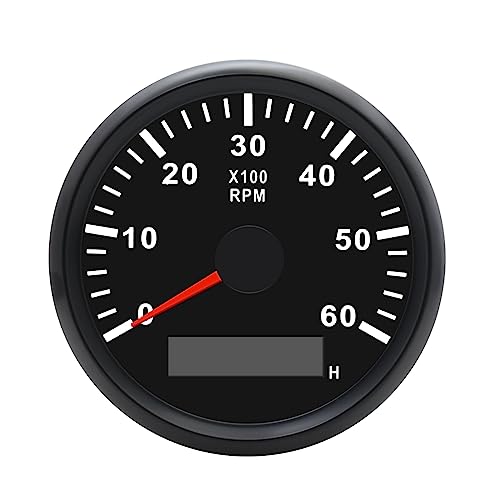What is a boat tachometer?
A boat tachometer is a device that measures the revolutions per minute of your boat engine and displays it on the gauged dial or digital display. It can be used to tell you how fast your boat motor is running at any given moment.
How does a tachometer work for an outboard motor??
An electronic tachometer uses a magnetic pickup positioned near a rotating engine part to produce electrical pulses at a frequency proportional to the engine speed. Circuitry in the meter converts the pulse frequency for display of engine RPM using an analog needle or a digital readout.How to use outboard tachometer
A boat tachometer usually has a boat tachometer head (often mounted on the boat's dashboard) and a boat engine sensor. First, you will need to connect your boat tachometer head with the boat engine sensor using red wire with a white stripe for positive power supply and black wire for ground connection.
How do I benefit from a boat tachometer?
Tachometers boat can be used to measure boat speed by measuring the boat's revolutions per minute. A boat tachometer is like a car odometer, it tells you how far or how fast your boat has traveled with one revolution of the shaft around the propeller. It also helps fishermen to find out if they're in an area where there are fish and assists boaters with handling their boat through rough water conditions.
What are the drawbacks of a marine tachometer?
A marine tachometer may not work on all types of boats because many recreational boats have engines that don't revolve at high speeds compared to commercial fishing vessels for example which cover more distance each time they go out into deeper waters. In this case, it would make sense to use GPS navigation systems.
Marine boat tachometers won't provide reliable readings because they are geared more towards conventional marine engines than smaller ones like those found on recreational fishing vessels. The best type of boat tacho would be one where you can input information such as engine size and hull design so that the device will be good for the concrete boat.
What is important when choosing a boat tachometer?
High degree of accuracy
Choose boat tachometers that have a high degree of accuracy. A marine boat tachometer is designed to work in boats with engines running at speeds from 1000 RPMs up to 5000 RPMs, but it may not be accurate for other types of boat motors. For boat tacho, boat speed is calculated by multiplying the circumference of the propeller at lower boat speeds.
Versatility
Despite its name, a marine boat tachometer isn't just for boats with marine engines; it also works well in recreational fishing vessels too! This type of boat tacho can be used on any engine running at 1000RPMs up to 5000 RPMs (although not all are accurate). But when choosing a boat tachometer you want one that has high accuracy so choose wisely.
Type
What boat tacho do you need? Well, the boat's engine type is important when deciding what boat tachometer to buy. For example, if your boat has a marine outboard motor running at 1200 RPMs or less then you will want one that runs from 1000RPM up to 5000RPM because it won't be accurate for higher speeds. But if your boat uses an inboard engine or other types of engines such as gas-powered and diesel-powered which run slower than 2000 RPMs (such as 1540), then there are always options available for those boats also!
Product Value
Boat tachometers can be expensive, but they are worth the investment. Boat owners know that a boat's engine is one of the most important features when it comes to getting from point A to point B - without an accurate boat tachometer, you'll never know just how quickly your boat is going! This makes buying a boat tachometer imperative for any boat owner.
Reliability
You want something with good accuracy and reliability because if not then you're out on the water driving around without knowing what speed you're actually at or how much fuel you have left in your tank (hopefully).
Quality
Though, boat tachometers that are made to be easy to use for inexperienced boat drivers will cost more because they typically have a lot of features. Do some research before getting one so you know which boat tacho to get and can help others in the future too.
Is the tachometer for the outboard motor worth it?
Whether a tachometer for an outboard motor is worth it depends on the individual's needs and preferences. Here are some factors to consider: Pros of having a tachometer:- Helps control cruising speed.
- Allows checking whether the engine is achieving maximum revs.
- Can help diagnose engine problems.
- Can help with maintenance by tracking engine hours.
- Difficulty controlling cruising speed.
- Difficulty checking whether the engine is achieving maximum revs.
- Difficulty diagnosing engine problems.
- Difficulty tracking engine hours for maintenance.











Comments to Review
SeaStar 68399P Tach 7K Eclipse 3″ has a scratch-resistant domed glass lens. U.S. and metric scales, with ISO symbols, where appropriate. Perimeter lighting for excellent readability at night.
The Hardline Products HR-8061-2 Hour Meter/Tachometer is a reliable and easy-to-install device. It works great for monitoring engine hours and RPM on various engines, including outboard motors. The display is clear and easy to read. The one-wire wrap installation makes it simple to set up. Overall, it’s a valuable tool for keeping track of maintenance and performance for your vehicle or equipment. Highly recommended ⭐⭐⭐⭐⭐